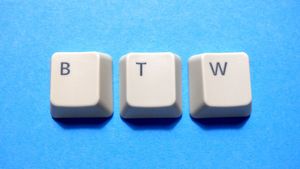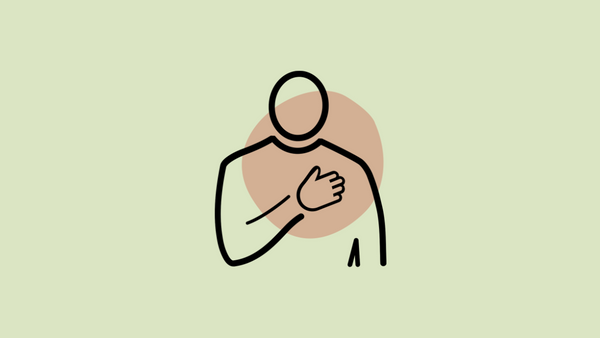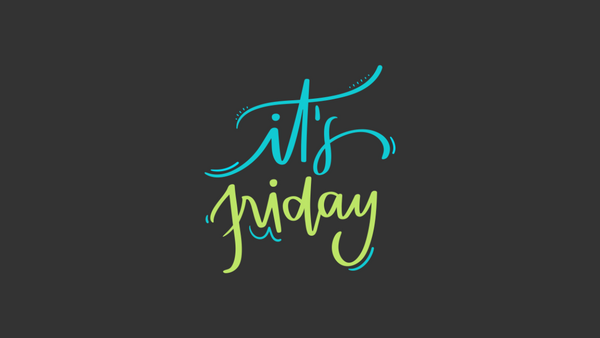There are numerous times when we interject a flow of speech with something unrelated to the founding context of a present conversation. Most times, this interjection is simply a crossroad sourcing from a previous conversation. Sometimes the interruption is completely random and certainly unexpected.
There’s a universal way in which we make such verbal disruptions that effectively and surprisingly keep the conversation seamless. When it’s put this way, it does seem like a shocking discovery, but we’ve been flawlessly talking about two or more things in one single dialogue. Here’s how ‘by the way’ began and how we’ve productively fitted its acronym into digital conversations.
BTW and It’s Implication

BTW expands to ‘By The Way’. It is used as a prefix to an intervention that’ll soon surface in an online conversation. The expansion is generally applicable to offline speech and the acronym, to online chats. In any case, ‘btw’ always hints at a follow-up conversation.
This means, although ‘btw’ is ideally a random insertion into an irrelevant topic, it is a contextual link to a past conversation or carries a future reference. ‘BTW’ is generally used before answering a question that was previously asked, providing updates on a previously discussed matter, stating a response, or bringing up an old conversation.
Apart from being a cue to an unpredictable, nonetheless previously occurred chat, ‘BTW’ also makes an appearance when enquiring about something. This acronym is used in both formal and informal conversations. For example, ‘Btw, didn’t get your name!’, ‘Where’s this located, btw?’, or ‘Btw. I don’t see the update we discussed on the sheet?’.
What Does ‘By The Way’ Even Mean?
Internet records about the origin of the phrase ‘by the way’ head way back to the 1500s. But, we aren’t certain of the factual truth. Nonetheless, we’re sure that the phrase and its use-case are quite old. ‘By the way’, ‘by the by’, and ‘by the bye’, all carry the same meaning. They’re all used before attaching information that is either interrogative or responsive relating to a context that has happened or is yet to happen.
The original expansion of the phrase is said to be ‘by the side of the road’; indicating a sidetrack conversation. Over years of usage, ‘way’ came to replace ‘the road’ and is now, ‘by the way’, which suggests information that the listener will catch up to once the speaker brings it up through their conversational journey.
How to Use BTW Online?
BTW has many intonations. It is not just used to ask or tell something, but it also accompanies positive and negative statements that can, at times, be strong. Contexts, as usual, play a big role while using BTW.
However, there is one defined parameter — the content after BTW must be a side point to the main conversation. It wouldn’t make sense to use ‘btw’ and continue with the same conversational context. Here are the ways you can use BTW online.
While reviving a previous context
This is the most common use case of the abbreviation. When you’re referring to an old conversation that happened in the recent past, you can use BTW to either request or provide new information.
For example, ‘Hey. What happened to the event you were talking about last week, btw?‘ or ‘BTW. She spoke to me last night. Call me up, I’ll tell you everything’.
While bringing up a forgotten conversation
A forgotten conversation is a little different than an old conversation. Most forgotten chats are old, but not all old chats are forgotten. Even in this use case, it is imperative to include new information — either asking or telling. Like:
- Btw. Remember the question you asked me a few months ago?
Uh.. about the resignation?
Yeah.
What about it?
I have answers. - What’s the update on the party, btw?
Oh, dude. That was ages ago, man. You ghosted all of us! - Btw, want to talk about that “difficult conversation”?
Nah, man. Went to therapy for it 🙂
Ohh! That’s amazing. Happy for you!
While stating your response
Another BTW use-case is while making a responsive statement; positive or negative. This can be a reply to a recent conversation, an unearthing session for an old and maybe forgotten chat, or an instant reply — but with a contextual gap. That is, there must be a shift in topic before using BTW in one conversation.
Here are some examples of using BTW while stating your response.
- Btw, I thought about the trip. AND I’M IN!!! To hell with routine!
- I’m not really uncomfortable with your meeting arrangement, BTW.
- So, are we working on the idea, or what?
Not sure, man. Still thinking.
Oh, cool. How’s the fam?
Oh, they’re devastated after the incident.
Man, I’m so sorry.
(hours/minutes of inactivity later)
BTW. I think it’s best we keep the business idea on hold, for now.
No problem, dude. Anything is fine by me 🙂
While giving an opinion
An opinion is a response, but with a minute change — it is based on personal preferences. A response is not always an opinion. You can use BTW to provide a personal opinion in an informal or formal context. Opinions, unlike responses, don’t have a continuum. They’re subjective and hence, cannot be positive or negative.
However, opinions are to be based on an old or new conversation (provided there’s a contextual bridge of topics). For instance, ‘BTW, I don’t agree with what you said last night.’, ‘I think it’s a great opportunity for her, btw’, or ‘Btw, I honestly feel he should be given more than just another passive-aggressive chance.’.
While being random
A highlighted persona of BTW is its randomness. Many times, the acronym is used to ask or sometimes, convey, completely different but somehow relevant information. This type of random use-case is generally applied amongst closer and informal circles but can appear in informally professional contexts as well. For example:
- Is the document ready?
Yes! It will be, EOD.
BTW, what you doing tonight?
Oh dude, nothing, actually.
Tuesday night drinks?
Have I EVER refused? - Oh.. that’s nice!
Yeah, he loves the toys you got for him!
BTW. Did you watch the news?
What? Haha. No, babe. I don’t do news.
Analysis
‘By the way’, its variations and acronym is a smooth way to deviate from a conversation while staying connected to a recipient(s). The derived acronym of the phrase ‘by the way’, which is largely used as the latter on digital platforms, helps piece together a previous or eventual context in the current chat. The expansion of BTW is applied in the same way, offline.
As mentioned before, ‘by the way’ denotes a brief moment of straying from the present conversation into a past or future context. This deviation depicts some possibilities –
- Our memory perks up during a particular conversation (like something in the chat that reminds us of something else).
- The deviation itself acts as a reminder of something that was said or done in the past or recent past.
- We hang onto an unanswered question and smoothly ask for an answer.
- We casually pose new questions or statements.
Nevertheless, BTW it is a graceful way of including a different subject matter in a separate but ongoing dialogue.
Conclusion
Both ‘by the way’ and its acronym ‘BTW’ are considerably used offline and online, respectively. They suggest a momentary but relevant digression from a present conversation topic.
The deviation is often familiar to the people involved in a conversation as it has been previously spoken or hinted at. BTW is also used to present new information that is often an inquiry rather than an answer.










Member discussion